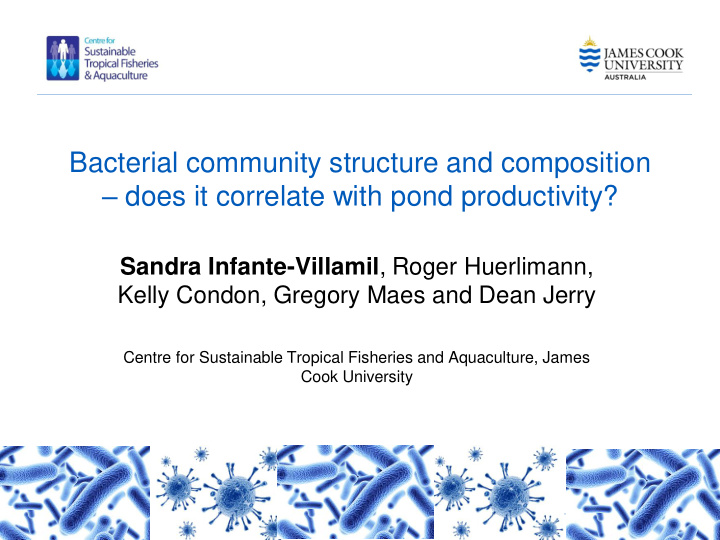



Bacterial community structure and composition – does it correlate with pond productivity? Sandra Infante-Villamil , Roger Huerlimann, Kelly Condon, Gregory Maes and Dean Jerry Centre for Sustainable Tropical Fisheries and Aquaculture, James Cook University
Challenges to shrimp farming Diseases Tran et al ., 2013 Wang et al ., 2000 Global Trade International shrimp barriers market prices industry Feed costs Introduction 2
Diseases Bacteria • Traditionally Causative agents of disease Non- biological agents • Recently Bacteria Host = Well-being Production losses Introduction 3
Gut microbiome Gut microbiome plays an important role in Development maintaining a host’s health of the immune system (Fernandez et al ., 2014). Caloric extraction Protection from against indigestible pathogens comp of diet Synthesis of ? Modulation of aa and metabolism vitamins Introduction 4
Bacterial community Bacterial community Culture Metagenomics methods 99% Introduction 5
Next generation Sequencing technology (NGS) Introduction 6
Bacterial community Bacterial community Aquaculture sector Host Environment Introduction 7
From single species detection to whole communities Introduction 8
NGS in prawn culture Number of Sample Location OTU samples Bali bay (non-polluted) 7 295 Faecal Bali aquaculture 10 269 Jakarta (polluted) 7 122 Introduction 9
Pond productivity Differences in pond productivity • Pond size • Stocking date (genetic stock) • Density of PL • PL from same hatchery Introduction 10
Research question • Are bacterial communities in the prawn (GUT and Gastric mill) and the environment (sediments and water) different in ponds with different productivity? Introduction 11
Sampling design Ponds P1(HP1) P2(HP2) P3(LP1) P4(LP2) High productive (HP) Low productive (LP) Sediment Intestine (GUT) and Gastric mill (GM) Water Sample Replicate 1 1 1 4 4 4 n = 3 n = 12 Ponds P1(HP1) P2(HP2) P3(LP1) P4(LP2) 3 3 3 1 1 1 3 3 3 1 1 1 n = 9 n = 3 n = 9 n = 3 Replicate Methods 12
Pond productivity (HP) • Standardized to most productive pond as determined by yield. • Pond size • Genetic stock Pond Yield (%) • Density of PL HP1 98 • PL from same HP2 100 hatchery LP1 42 LP2 43 Results 13
Bacterial richness (OTU) 137 147 116 152 146 102 77 79 Sediment and water GM and GUT LP Results 14
Bacterial community Water LP HP Gut and GM Sediment Results 15
Bacterial community GUT GM LP LP HP HP Results 16
Relative abundance High Productive Low Productive Genus GM GUT Sed Wat GM GUT Sed Wat X X Photobacterium X X X X Vibrio X X X X Candidatus bacilloplasma X X Fusibacter X X Propionigenium X Ferrimonas X X Candidatus aquiluna X X Salinihabitans X X Prochlorococcus X X Thiohalophilus X X Thioalkalispira X X Desulfobulbus X Desulfococcus Results 17
Relative abundance Results 18
Relative abundance High Productive Low Productive Genus GM GUT Sed Wat GM GUT Sed Wat X X Photobacterium X X X X Vibrio X X X X Candidatus bacilloplasma X X Fusibacter X X Propionigenium X Ferrimonas X X Candidatus aquiluna X X Salinihabitans X X Prochlorococcus X X Thiohalophilus X X Thioalkalispira X X Desulfobulbus X Desulfococcus Results 19
Relative abundance High Productive Low Productive Genus GM GUT Sed Wat GM GUT Sed Wat X X Photobacterium X X X X Vibrio X X X X Candidatus bacilloplasma X X Fusibacter X X Propionigenium X Ferrimonas X X Candidatus aquiluna X X Salinihabitans X X Prochlorococcus X X Thiohalophilus X X Thioalkalispira X X Desulfobulbus X Desulfococcus Results 20
Relative abundance High Productive Low Productive Genus GM GUT Sed Wat GM GUT Sed Wat X X Photobacterium X X X X Vibrio X X X X Candidatus bacilloplasma X X Fusibacter X X Propionigenium X Ferrimonas X X Candidatus aquiluna X X Salinihabitans X X Prochlorococcus X X Thiohalophilus X X Thioalkalispira X X Desulfobulbus X Desulfococcus Results 21
Pearson’s correlation Prawn weight Abundance of Vibrio associated with prawn weight Results 22
Insights High productive Low productive • Gut and GM • Gut and GM Photobacterium and OTU richness Candidatus bacilloplasma Vibrio , Fusibacter and Vibrio Propionigenium • Sediment • GUT Desulfococcus Ferrimonas $ $ 23
Insights • Bacterial communities Water ≠ Sediment ≠ GUT and GM (selective pressure) Chaiyapechara et al. (2012), and by Cardona et al. (2016) in water and GUT . • Vibrio – ˃ 50% bacterial community in GUT and GM in LP. AND – Abundance prawn weight 24
Insights and future • NGS technology + bioinformatics ✓ Enable the understanding of the microbial diversity thriving in aquaculture ponds. ✓ Associations among microbial communities and prawn genotype or phenotype + environmental factors? ✓ Selection of potential probiotic candidates? (e.g. Candidatus bacilloplasma ). Effect in survival, growth, water quality. 25
Microbiome 26
Acknowledgements • Commercial partner • JCU – Aquaculture Genetics Group 27
Questions? 28
Recommend
More recommend